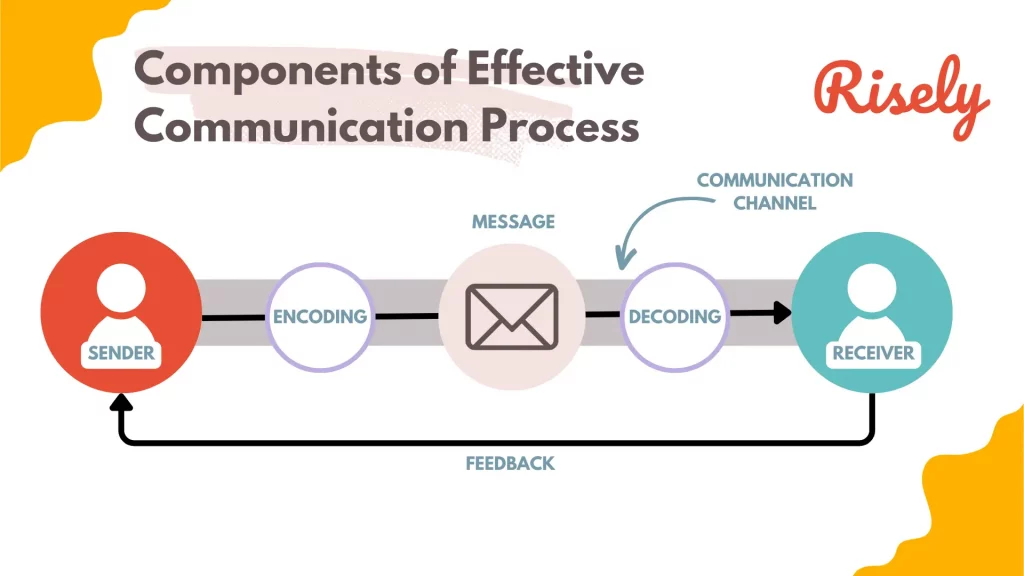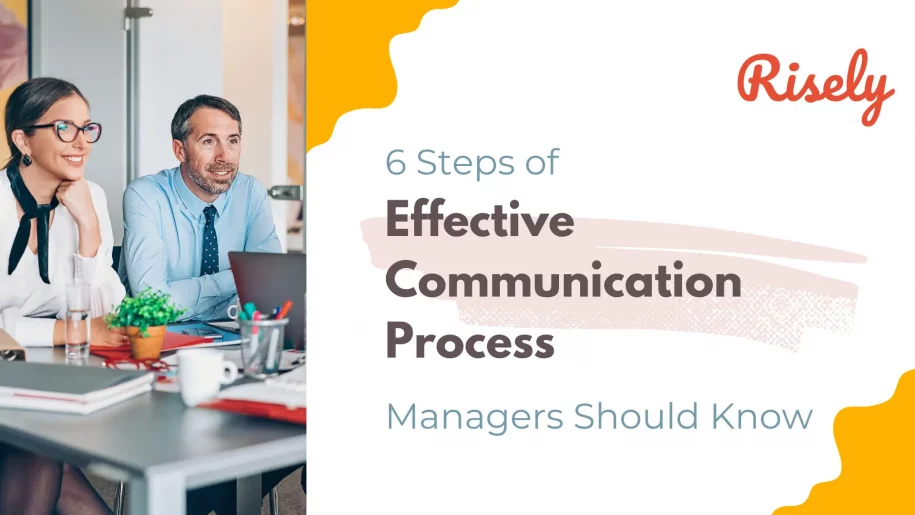6 Steps of Effective Communication Process Managers Should Know
Communication is the key to success, whether it’s at work or in your personal life. It allows us to express ourselves clearly, fostering better connections. In this blog, we’ll explore the 6 steps of communication, share some useful strategies, and provide tips for effective communication at work. Whether you’re a pro or just aiming to enhance your skills, this blog is a must-read for building meaningful relationships in the workplace. So, let’s dive in and uncover the secrets of effective communication together!- 6 Steps of Effective Communication Process Managers Should Know
- What is effective communication?
- Types of communication in the workplace
- How does effective communication work?
- Key Components of the Communication Process
- 6 Steps of the Effective Communication Process
- 5 Effective Communication Strategies in the Workplace
- How to ensure your communication is clear, well-structured and tailored to your audience?
- Conclusion
- Other Related Blogs
What is effective communication?
Effective communication is exchanging information and ideas between individuals in a clear, concise, and meaningful way. It involves active listening, speaking, and writing, understanding the recipient’s perspective, encouraging two-way communication, adapting to the audience and context, and verifying understanding through feedback. Effective communication is crucial for building relationships, fostering mutual understanding, and achieving personal and organizational goals.Types of communication in the workplace
- Verbal communication: The use of spoken language to convey information and ideas in the workplace. This can be face-to-face conversations, telephone calls, or video conferencing.
- Non-verbal communication: This refers to all forms of communication that are not verbal, including body language, facial expressions, and tone of voice. These cues can significantly influence the meaning of a message.
- Visual communication: This type of communication uses images, charts, graphs, and other visual aids to convey information clearly and concisely.
- Written communication: This refers to written forms of communication, such as emails, reports, and memos, used to convey information in the workplace. Effective written communication requires clear, concise, and well-structured language.
- Listening: This is an active process of paying attention and understanding the message being communicated by others. Good listening skills are crucial for effective communication in the workplace, as they help to build trust, clarify misunderstandings, and foster mutual understanding.
How does effective communication work?
Effective communication is not just about conveying ideas and information; it is more than that. Effective communication helps us understand the feelings and objectives behind the idea or information. Effective communication is not only listening carefully or conveying your thoughts to others; it is creating a balance between both and making the communicator feel heard and understood. Communicating effectively might sound easy but believe me, and it is pretty tricky. We will discuss the steps of communication process to make communication easier.What is the importance of effective communication?
- Builds relationships: Good communication helps to foster trust, respect, and understanding between individuals and teams.
- Improves mutual understanding: Effective communication minimizes misunderstandings and reduces conflict by ensuring that the message being conveyed is understood.
- Achieves personal and organizational goals: Effective communication enables individuals and organizations to achieve their goals more efficiently by ensuring that information is accurately and effectively conveyed.
- Enhances productivity: Good communication helps to streamline processes, reduce mistakes, and increase productivity and efficiency.
- Promotes innovation and creativity: Effective communication encourages an open and honest exchange of ideas and perspectives, which can lead to new and innovative solutions.
Key Components of the Communication Process
Communication is a vital step of any process. It is vital in bringing team members together and helps them exchange ideas, opinions, information, and other things necessary to reach the same goal. However, communication is challenging as it requires skills and an understanding of the process. Nevertheless, well-planned communication can help to reach a positive outcome. Here are the key components of the communication process:
- Sender: The sender is the person who comes up with ideas and initiates communication.
- Encoding: The encoding stage involves translating the message into a form other team members can understand.
- Message: The message is the key component of any communication process. It is the idea or information that the sender wants to convey.
- Communication channel: This method is used to transmit or deliver a message.
- Receiver: The receiver is the audience or team members to whom the message is delivered.
- Decoding: Decoding is the process of interpreting or analyzing the message sent by the sender to the receiver.
- Feedback: Feedback is the reaction or response given by the receiver to the sender’s idea.
Other Interesting Reads
6 Steps of the Effective Communication Process

Developing the message
The first step of communication process is to develop a message. To develop a message, the sender should have an idea they want to communicate to other team members. This involves thinking about:- The purpose of the message
- Who it is for, and what it should accomplish
- What does the sender want the receiver to do with the message?
Encoding the message
Communication is a vital part of our daily lives. Communication involves encoding the message into a form that the receiver can understand. This process involves breaking down the message into its components and then constructing those components in a way that makes sense to the receiver. Before sending the message forward, the sender must understand the receiver’s communication style:- Does the receiver know about the topic?
- What is the communication style of the receiver? Detailed information or general overview?
- Will the receiver need any additional material or resources to support their judgment?
Selecting the channel
Selecting the appropriate communication channel depends on the situation and the individuals involved. The sender must think carefully about how they want to send the message; based on that, the channel should be selected to communicate it effectively. The sender must consider the four communication channels: verbal, non-verbal, visual, and written. By selecting the appropriate communication channel, the sender increases the chances of the recipient accurately receiving and understanding the message.Message Transmission
The sender must select the best way to send the message to the receiver based on the relationship, their understanding of the information, and the purpose and urgency of sending it across. This step of communication process involves sending the message across.Decoding the message
When communicating with someone, it is important to decode the message being sent. It is essential to take steps to decode the message when communicating with someone. In order to decode the message, it helps to gather data about the sender’s interests and motivations, as well as about the context of communication. Once you have gathered data about the sender, you can start to identify their interests and motivations and establish a context for communication. This allows you to understand the message being sent better and develop a plan of action for decoding it. By developing a plan of action for decoding the message, you can tailor your communication strategies to address the issue effectively. In this step of communication, the receiver decodes the message received by the sender. It is done by understanding the message’s context and connotation, processing the information, and critically analyzing it. If the receiver understands the message’s meaning clear, it indicates the effectiveness of the step of the communication process.Feedback
Feedback is the last and most crucial step of the communication process. In this step, the sender needs to collect feedback on their communication skills to improve their communication skills for the future. The sender should find answers to the questions like:- Could the sender have done anything differently to receive a better outcome?
- Did the receiver of the message have the chance to clear their doubts?
- Could the sender understand the non-verbal cues while communicating the information?
5 Effective Communication Strategies in the Workplace
- Meet the employees regularly: Regular meetings between managers and employees help to ensure everyone is on the same page and help to foster open communication and a sense of belonging among employees.
- Create an open environment for communication: Creating an open environment can foster trust and encourage employees to express their thoughts, ideas, and concerns. This can be achieved by allowing employees to share their opinions during meetings or encouraging an open-door policy where employees can approach their manager at any time.
- Give clear instructions: It is an effective communication strategy because it reduces misunderstandings and increases productivity. When instructions are well-defined, employees know exactly what is expected and can focus on delivering the desired results.
- Acknowledge achievements: Acknowledging employees’ achievements helps to motivate and engage them, and can also help to foster a positive work environment. This can be done through verbal recognition, awards, or by including employees’ accomplishments in company newsletters or other communications.
- One-on-one meetings: Regular one-on-one meetings between managers and employees provide an opportunity for individualized communication and feedback. This can be an effective way to address specific concerns or to provide tailored support and guidance to employees.
How to ensure your communication is clear, well-structured and tailored to your audience?
- Listen actively: Listening is an essential part of effective communication, but it is important not just to hear the words being said but to actively listen and understand the speaker’s message.
- Know your audience: Understanding the needs and expectations of your audience is essential for effective communication. Tailor your message to the specific audience to ensure it resonates with them.
- Face-to-face meetings: Face-to-face communication is a powerful tool for building relationships and conveying complex information. Holding regular face-to-face meetings can foster open and productive communication.
- Use verbal and non-verbal cues: Effective communication often involves a combination of verbal and non-verbal cues, such as tone of voice, body language, and gestures. Paying attention to both forms of communication helps reinforce the message being conveyed and build understanding.
- To learn more effective communication tips like these, read the blog on 7 Effective Communication Tips That Every Manager Should Follow.
Conclusion
In conclusion, effective communication is crucial in our daily lives and can significantly impact our personal and professional relationships. By understanding the 6 steps of the communication process and implementing various strategies and tips, you can enhance our ability to communicate effectively and build stronger relationships with those around you. Remember, effective communication is not just about speaking or writing clearly, but also actively listening and understanding the perspectives of others. With time and effort, you can develop your communication skills and enjoy the benefits of effective communication in your daily life.Check the effectiveness of your communication process to save your team today
Risely’s free communication skills assessment for managers reveals blind spots that hold back strong managers
Other Related Blogs
Executive Communication Coach: When And How To Choose
Executive Communication Coach: When And How To Choose Good communication is a must for professional success. After all, half of people management is all about saying the right things in…
Emotional Intelligence In Communication: 5 Ways Smart Leaders Act
Emotional Intelligence In Communication: 5 Elements Smart Leaders Use Effective communication is the cornerstone of a thriving workplace. It doesn’t matter if you’re speaking to your team members, clients, or…
15+ Sales Manager Best Practices to Boost Your Team’s Performance
15+ Sales Manager Best Practices to Boost Your Team’s Performance As a sales manager, you are responsible for achieving your targets and driving your team’s performance. It’s easy to get…
Communicating Employee Benefits is Essential: 5 Hacks to Do it Right
Communicating Employee Benefits is Essential: 5 Hacks to Do it Right Employee benefits are crucial in attracting, retaining, and engaging employees. However, it’s not enough to simply provide benefits; effectively…


